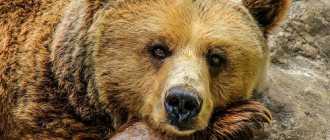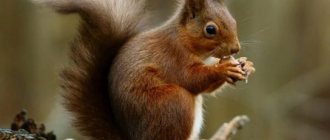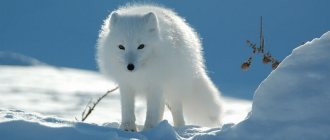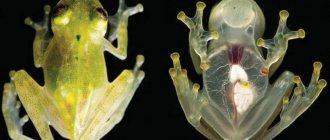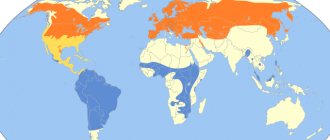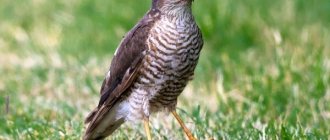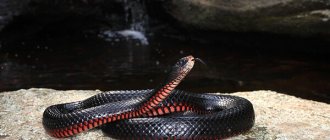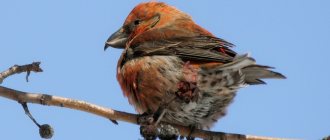Origin of the species and description
Photo: Malayan bear
The Malayan bear is a distant relative of the familiar cute bears - giant pandas. Moreover, it has the smallest size among all representatives of the bear family, since its weight never exceeds 65 kg.
Helarctos is the name of the bear, given to him by local residents and confirmed by zoologists, where translated from Greek: hela - sun, and arcto - bear. The animal received this name probably because the spot on its chest, which has a shade from white to light orange, is very reminiscent of the rising sun.
Giant panda or bamboo bear
The bamboo bear (Ailuropoda melanoleuca) is a vulnerable species Most of the giant panda's body and belly are white, contrasting sharply with the black ears, black limbs and shoulders, and black spots above the eyes. It has a relatively large head and large, muscular jaws that allow it to crush bamboo. Today, the bear's distribution is limited to six distinct mountain ranges in western China, on the eastern edge of the Tibetan Plateau, in the provinces of Gansu, Shaanxi and Sichuan.
Appearance and features
Photo: Biruang
The biruang, the smallest bear known to science, has an elongated, awkward, stocky body about 150 cm long, a height of no more than 70 cm, and a weight of 27 to 65 kg. Male bears are usually slightly larger than females, not by much - only 10-12 percent.
The animal has a wide short muzzle with strong large fanged teeth, small rounded ears and small eyes that do not see very well. At the same time, the lack of visual acuity in bears is more than compensated by their simply perfect hearing and sense of smell.
The animal also has a sticky and long tongue, which allows it to easily feed on termites and other small insects. The biruang's paws are quite long, disproportionately large, very strong with long, curved and incredibly sharp claws.
Despite some awkwardness in appearance, the Malayan bear has very beautiful fur - short, smooth, shiny, pitch-black in color with water-repellent properties and reddish tan marks on the sides, face and a light contrasting spot on the chest.
Gubach
A bear with a strange name is a neighbor of the Himalayan bear, living in India, Sri Lanka and Nepal. Yes, and its coloring is similar to him, only the fur is long and thick, so the shaggy sloth fish looks like an uncut hippie.
It is named so because to eat food it folds its long lips into a tube and stretches them out, making faces.
He can blow out the bark and suck up termites like a vacuum cleaner, and he does it so loudly that the whole neighborhood can hear it. Another assistant in getting food is its long claws, which it uses to break trees. The sponge bear’s menu also includes plants, berries and honeycombs. The lipped bear is small in size, weighing up to 100 kg.
Did you know?! The sloth snake crawls along date palms and easily sucks the juice from the fruits.
Where does the Malayan bear live?
Photo: Biruang, or Malayan bear
Malayan bears live in subtropical and tropical forests, on swampy plains and gentle foothills of the islands of Borneo, Sumatra and Java, on the Indochina Peninsula, in India (northeastern part), Indonesia, Thailand and lead a predominantly solitary lifestyle, with the exception of female bears with cubs and periods when mating occurs.
Benefits and harms for humans
Despite the fact that the number of Malayan bears is declining every year, people continue to mercilessly destroy them. Many hunt them for sport and also kill them for sale.
Some parts of the biruang's body are used in medicine. This practice began in China around 3500 BC. e., and the first mention of the use of the biruang gall bladder dates back to the 7th century AD. e. Bear bile is successfully used in Chinese medicine. It is used to treat bacterial infections and inflammation. There is an opinion that the bear's gall bladder (remedies from it) can increase the potency of men.
Hats are made from biruang fur on the island of Borneo. In some areas, bears play an extremely important role in dispersing plant seeds.
Unfortunately, the Malayan bear is capable of causing irreparable damage to coconut and banana plantations.
What does the Malayan bear eat?
Photo: Malayan bear from the Red Book
Although Malayan bears are considered predators - they hunt small rodents, mice, voles, lizards and birds, they can also be omnivores, since they never disdain carrion and food remains of other larger predators.
Their menu also contains in abundance:
- termites;
- ants;
- bees (wild) and their honey;
- earthworms;
- bird eggs;
- tree fruits;
- edible roots.
From local residents of the regions where these unusual bears live, you can often hear complaints that biruangs severely damage banana plantations, eating tender shoots of banana palms and young bananas, and also that cocoa bean plantations suffer greatly from their frequent raids .
Animal nutrition
Like most bears, the Malayan is omnivorous. The animal's daily diet includes:
- termites;
- ants;
- wild bees and their larvae;
- palm sprouts;
- lizards;
- small birds;
- small mammals;
- bananas.
They eat Malayan clubfoot and other fruits of the tropics, but most of all they love honey. Therefore, representatives of the species are also called honey bears.
Malayan bear cubs
Features of character and lifestyle
Photo: Malayan bear
Biruangs are predominantly nocturnal animals and good tree climbers. At night they feed on tree leaves, fruits and ants, and during the day they doze among the branches or bask in the sun at an altitude of 7 to 12 meters. At the same time, one of the distinctive features of animals is the ability to make nests or hammocks well from branches, bending them in a special way. Yes, yes, exactly making nests. And they do it perfectly - no worse than birds.
In their nests, bears usually rest or sunbathe during the daytime. This is where another name comes from: “sun bear”. In addition, the Malays in their language call these bears nothing more than: “basindo nan tenggil”, which translated means: “the one who likes to sit very high.”
Biruangs, unlike their more northern brothers in the family, are not inclined to hibernate and do not strive for this. Perhaps this feature is associated with a warm tropical and subtropical climate, in which weather conditions are more or less constant, do not change sharply, and in nature there is always a sufficient amount of food for them, both plant and animal.
In general, biruangs are calm and harmless animals that try to avoid humans whenever possible. However, sometimes it happens that bears behave very aggressively and unexpectedly attack other animals (tigers, leopards) and even people. In most cases, this behavior is characteristic not of lonely males, but of females with cubs, who probably believe that they may be in danger.
Teeth, tongue and claws... Why?
The tongue reaches 30 cm.
The question arises: why does a bear have such teeth and claws if a biruang can safely be called a vegetarian?
It's simple: sharp claws are necessary for climbing trees. Something, and the sun bear masters this skill perfectly. When not searching for food, representatives of the species sit high, high in the trees and look into the distance. And some people, in addition to sitting idle, also eat succulent leaves.
By the way, it has long been known: biruangs not only sit and eat in trees, they also build “sleeping” nests. The nests are neatly folded leaves stacked on top of each other directly on the branches. The sleeping place, frankly speaking, is a little creepy, you could fall from it. But bears like this kind of bedroom.
In addition to helping you climb trees, claws are an excellent opportunity to dig up an anthill, destroy a termite mound or bee hives. Biruangas are hungry for honey and insect larvae; representatives of the species are not afraid of bee stings.
And teeth are required in order to crack the hard nut shell. Sun bears are coconut lovers.
As for the long tongue, which resembles fly-catching tape, it is used to pull termites out of termite mounds. What can you do, the honey bear is not indifferent to these insects and eats them with pleasure.
Social structure and reproduction
Photo: Malayan sun bear
As mentioned above, Malayan bears are solitary animals. They never gather in flocks and are completely monogamous, that is, they form strong pairs, but only during mating games. Upon completion, the couple breaks up and each of its participants goes their own way. They reach puberty between the ages of 3 and 5 years.
The mating season of biruangs can last from 2 to 7 days, sometimes longer. A female, ready for mating, along with the male, takes an active part in the so-called mating behavior, which is characterized by prolonged courtship, playful wrestling, jumping, a demonstrative game of catch, tight hugs and other tenderness.
Surprisingly, mating in Malayan bears can occur at any time of the year - be it summer or winter, which indicates that this species does not have a mating season as such. As a rule, pregnancy in Malayan bears lasts no longer than 95 days, but there are frequent cases, described in several zoos, when pregnancy could last twice or even almost three times longer than usual, which could probably be due to nothing more than a delay penetration of a fertilized egg into the uterus. A similar phenomenon of delayed fertilization occurs quite often in all species of the Bear family.
Females usually give birth to one to three young. Before giving birth, they spend a long time looking for a secluded place, carefully arranging it, preparing some semblance of a nest from thin branches, palm leaves and dry grass. Biruang cubs are born naked, blind, helpless and very small - weighing no more than 300 g. From the moment of birth, the life, safety, physical development and everything else of the little cubs is completely dependent on their mother.
In addition to mother's milk, which they suck until about 4 months, newborn cubs up to 2 months of age also need external stimulation of the intestines and bladder. In nature, this care is provided to them by the bear, often and thoroughly licking her cubs. In zoos, for this purpose, bear cubs are washed several times a day, directing a stream of water to their tummies, thus replacing maternal licking.
Biruang babies develop very quickly, literally rapidly. By the age of three months, they can run fast, play with each other and with their mother, and eat additional food.
Immediately after birth, the skin of babies is black-gray with short, sparse fur, and the muzzle and characteristic spot on the chest are dirty white.
Babies' eyes open around the 25th day, but they begin to fully see and hear only by the 50th day. The female, all the time while the cubs are with her, teaches them where to find food, what they can eat and what they cannot. After 30 months, the cubs leave their mother and begin their lonely, independent lives.
What do all bears have in common?
Bears are animals with thick paws equipped with curved claws. All bears rest on their entire foot when walking, which is why they are called plantigrade. That is why they will never be graceful ballerinas, they are clumsy by nature and it is not for nothing that the nickname “clubfooted” stuck to them.
They reach speeds of up to 50 km per hour. And all breeds eat differently. Only the polar bear is a notorious meat eater; others may have plants, berries, and fruits on their menu. There are vegetarians among them.
The bear family includes 8 species.
Natural enemies of Malayan bears
Photo: Bear-dog
In the natural environment, the main enemies of Malayan bears are mainly leopards, tigers and other large representatives of the cat family, as well as crocodiles and large snakes, mainly pythons. To protect themselves from most predators, biruangs have a very convenient and unique anatomical feature: very loose hanging skin around the neck, falling onto the shoulders in two or three folds.
How it works? If a predator grabs a bear by the neck, it twists out with ease and virtuosity and painfully bites the offender with its strong fangs, and then uses its long sharp claws. This feature almost always takes the predator by surprise and before he has time to come to his senses, his seemingly helpless victim, having hurt him, has already quickly run away and hid high in a tree.
Baribal, or black bear
Baribal, or black bear (Ursus americanus) is a North American species. Most hibernate for up to seven months, but in the south, where plant food is available year-round, not all bears hibernate except for pregnant females. The female gives birth to 1-6 cubs (usually 2 or 3) in January while she sleeps deeply in her den. Black bears eat some meat as well as some insects and rely mainly on fruits, nuts and plant foods.
Population and species status
Photo: Malayan bear (biruang)
Today, the Malayan bear (biruang) is considered a rare animal, listed in the Red Book under the status: “an animal species that is in danger of extinction.” It is also included in Appendix No. 1 of the Convention on International Trade in Endangered Species of Wild Flora and Fauna. Inclusion in such a document categorically prohibits any international trade in biruangs.
A rare exception to this rule is the strictly limited sale of Malayan bears only to replenish zoo collections. At the same time, the sale procedure is quite complex, bureaucratic and requires a large number of different permits and certificates from the zoo wishing to purchase biruang.
Zoologists and other specialists do not name the exact number of biruangs, but they state the fact that their numbers are decreasing every year, and at a very alarming rate. The leading role in this process is, of course, played by humans, who constantly destroy the habitat of animals.
The reasons for the decline in the Malayan bear population are trivial:
- deforestation;
- fires;
- use of pesticides;
- irrational and unjustified destruction.
The above-mentioned factors are increasingly pushing biruangs into very small territories isolated from civilization, where they lack food and do not have very good conditions for living and breeding.
Interesting Facts
Biruang really looks like a dog
- Speaking about the smallest bear in the world, it is simply necessary to tell something about it.
- For example, representatives of the species turn all four paws inward when walking.
- These animals are very smart. An interesting incident occurred in one of the zoos. When the biruangs were fed, one of them refused to eat rice. The animal left the grains on the ground at the entrance to its “abode.” Soon the birds arrived, eager to eat the rice. It was then that the bear had lunch.
- Sun bears love plants. Animals are known to eat more than 300 types of vegetation.
- In captivity, biruangs live up to 30-35 years.
- The main diet in captivity is vegetables. Fruits and mealworms.
- These are the smallest bears in the world. Real climbers, cunning and smart, lovers of tasty things.
